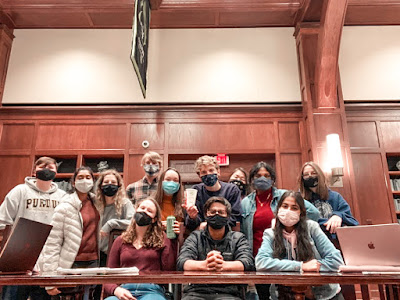Social Aspects Within Engineering Disciplines
Each engineering major at Purdue is unique and has characteristics that define it. Some majors graduate hundreds of students each year, while others only graduate a couple dozen. Understanding the social aspects and study group dynamics of each major is important while thinking about where you see yourself here at Purdue.
First Year Engineering:
Of the 41,000 students that Purdue enrolls at West Lafayette, over 30% of those students are majoring in engineering. So, entering into this sea of engineers in your first year can be intimidating. Fortunately, for us first year engineers, we have close to 2,500 other students in the same boat as us. The classes that first year engineers take are generally larger and professors encourage students to sit in a new seat every class and introduce yourself to a new person. We can find comfort in meeting people with similar interests and ambitions in these classes. However, since engineering consists of many different majors and specialities and Purdue welcomes students of various backgrounds, you will also be taken out of your comfort zone and be able to meet interesting and exciting people. And even though almost half of the semester has passed, I am still getting to know the people in my classes. I’ve met people from various states of the US as well as students from the Philippines, Saudi Arabia, South Korea and many more countries. Yet, as first year engineers, we are not just limited to befriending other engineers. Since we need to take more general classes to fulfill basic requirements, like communications or science electives, we meet people from other majors in our classes too. Through my philosophy and law, math and physics courses, I’ve met students in various majors and years which is pretty refreshing.
Large major:
ME is one of the largest majors on campus with an undergraduate enrollment of 1,400 students, according to the Mechanical Engineering Fact Sheet. Only 15% of these undergraduate students are women, which can be intimidating at first, but is easy to adjust to. Because the major is so large, it is not possible to be friends with and work with everybody, so it’s nice to have a small group of people that are reliable and helpful. Having people to study with that have the same professors and different professors is important because people with different professors may learn and explain things in a more beneficial way to you. Relationships within ME need to be mutually beneficial, too, because it’s only fair to receive as much help as you’re giving out. Having a small, balanced friend group is very important in order to make the large majors such as Computer, Aeronautical & Astronautical, Electrical, and Industrial Engineering. Ways to do this include sticking with your friends from FYE that choose the same major as you, introduce yourself to people in your classes, and see who else is going to help rooms, office hours, and review sessions. More than likely, these are people that are willing to learn and share a mutually beneficial friendship.
Medium school:
Within Civil Engineering, there are around 200 students per grade. Once you delve into your sophmore year and your first CE classes, faces start to look familiar. It is the beginning of a three year journey with friends and peers that will help support and walk with you until the finish line. Most students find a few friends in classes or from different activities - some even Civil Engineering related. From there, you spend countless hours in help rooms, in libraries, and in class pushing each other to finish all weekly homework assignments and labs. Once I was a sophomore in Civil Engineering, we created a “Civil Engineering” Group Me where people can connect easily with all their peers to ask any clarification questions on exam times, homework due dates, and study resources. Overall, each student is very enthusiastic to help the next. After all, Civil Engineering will always be about problem solving alongside your peers; the relationships you make during your studies at Purdue help prepare you for that. While the medium sized majors, including Biomedical, Chemical, and Materials Science Engineering, may be less overwhelming, it is still important to find your close-knit study group.
Small school:
Agricultural & Biological Engineering is one of the smaller engineering majors at Purdue. According to Purdue Engineering Degree Programs & Enrollment 2019, there were 71 new students enrolled in the program this fall and 33 enrolled in the pre-ABE program. Out of the combined 104 undergraduate students, 52% are women, which is the second highest percentage of women in an engineering discipline at Purdue. Because of these small numbers, by the end of the four years, everyone in the same grade gets to know each other, usually due to mutual classes. The ABE class sizes are small, with only about 20 people per class. This makes forming study groups easier, as the other 19 people in the class will also be looking for study buddies. Additionally, because the ABE curriculum is focused on lab work, there will be plenty of opportunities to be placed with new groups of people as well. These study groups can quickly change to close friendships due to the large amount of time everyone spends together, both inside and outside the classroom. Other small engineering majors include Construction Engineering, Environmental & Ecological Engineering, Multidisciplinary Engineering, and Nuclear Engineering.
- Grace Filley ABE ‘21, Cassidy Viox ME ‘22, Joanna McCormack CE ‘21
Recruitment Project Committee
Stay Connected With Purdue WIEP!
Facebook: Purdue Women in Engineering
Twitter: @purduewiep
Instagram: @purduewiep
Blog: purduewiep.blogspot.com
Email: welink@purdue.edu
Use the hashtag #PurdueWIEP on Facebook, Instagram and Twitter!
Tweets by PurdueWIEP




Comments
Post a Comment